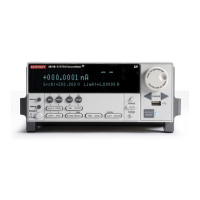2600S-901-01 Rev. C / January 2008 Return to Section Topics 2-49
Series 2600 System SourceMeter® Instruments Reference Manual Section 2: TSP Programming
print(nil and 13)
print(false and 13)
print(4 or 5)
print(false or 5)
Output of code above:
5
nil
false
4
5
Both and and or use short-cut evaluation, that is, they evaluate their second operand only when
necessary. A useful TSL construct is
x = x or v, which is equivalent to:
if not x then x = v end
For example, it sets x to a default value v when x is not set (provided that x is not set to false).
To select the maximum of two numbers x and y, use the following statement (note the and
operator has a higher precedence than
or):
max = (x > y) and x or y
When x > y is true, the first expression of the and is true, so the and results in its second
argument
x (which is also true, because it is a number), and then the or expression, results in the
value of its first expression,
x. When x > y is false, the and expression is false and so are the or
results in its second expression,
y.
The operator not always returns true or false:
print(not nil)
print(not false)
print(not 0)
print(not not nil)
Output of code above:
true
true
false
false
Concatenation
TSL denotes the string concatenation operator by “..” (two dots). If any of its operands is a number,
TSL converts that number to a string:
print("Hello ".."World")
print(0 .. 1)
Output of code above:
Hello World
01

